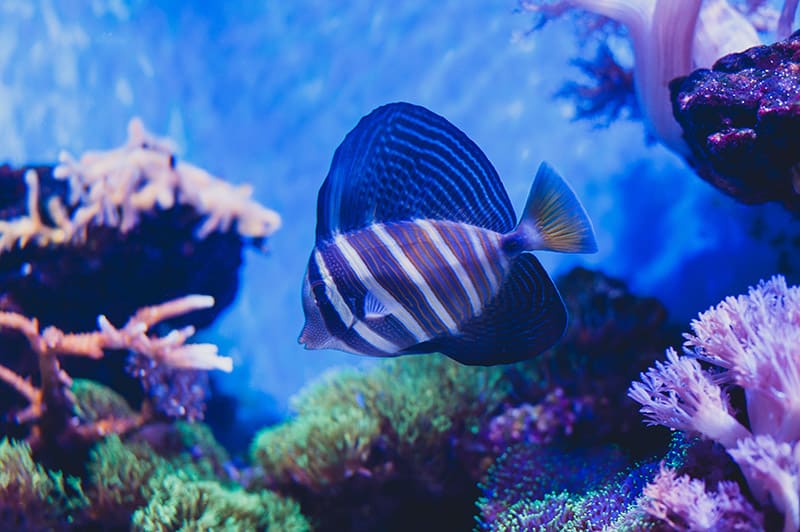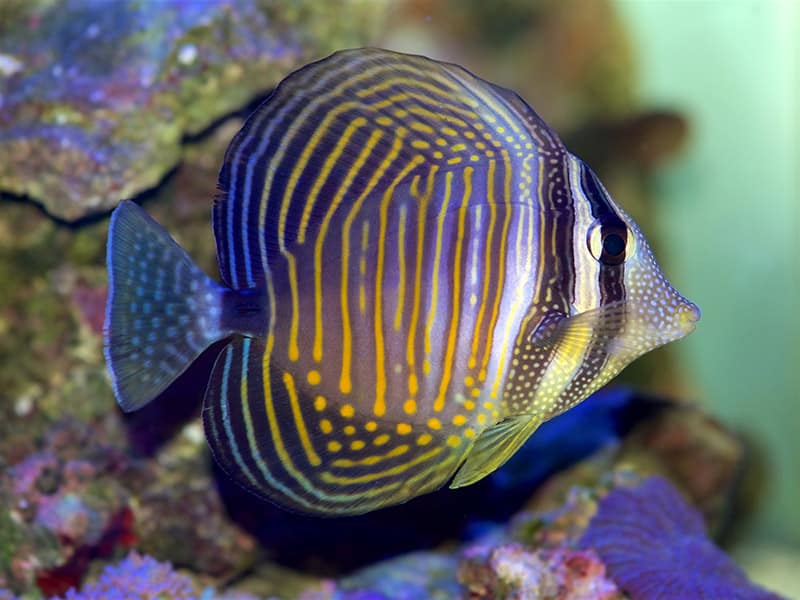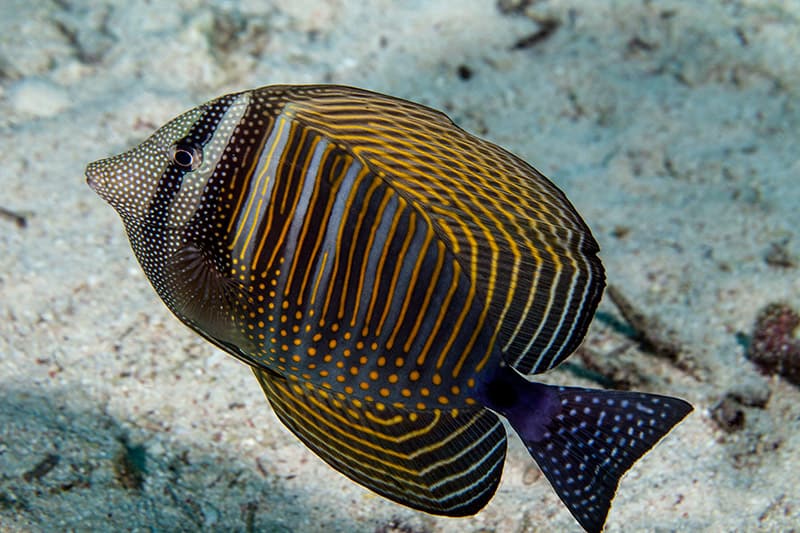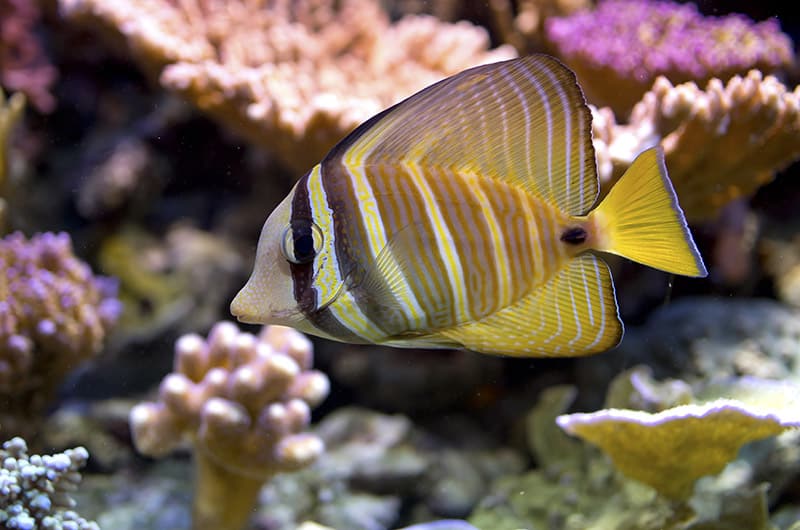The Desjardin’s Sailfin Tang or Red Sea Sailfin Tang is a delightful tang, enjoyed for its wonderful patterning and its attractive coloration!
Like all seven of the sailfin tang species, when the fins of the Desjardin’s Sailfin Tang are fully extended its height is about the same as its length, giving it a disk-shaped appearance. It is hard to tell the difference between this sailfin tang and its very similar relative the Pacific Sailfin TangZ. veliferum when they are both young. However the adult Desjardin’s Sailfin Tang will change stripes for spots and lightens in color while the adult Pacific Sailfin Tang retains its juvenile coloration. The Desjardin’s will also get quite big, in fact these two fish are the largest of the seven Zebrasoma species. When acquired as a juvenile, which is what is most available from a marine supplier, it is an easy tang to keep.
The Desjardin’s Sailfin Tang or Red Sea Sailfin Tang makes a wonderful addition to the marine aquarium, especially a large community aquarium. It is relatively peaceful and will get along with a wide variety of like minded tank mates, but should be added last. Keep it singly as it does not mix with others of its same genus. Bold in nature, it will quickly adapt to aquarium fare and is easy to care for once it is settled. One of the hardiest of the surgeonfish, it is highly disease resistant and responds well to treatment.
There are some things that the Zebrasoma species have in common with all the surgeonfish and tangs. They like plenty of water movement to provide an oxygen rich environment rather than a placid aquarium. They are quick and agile swimmers so will need lots of swimming space along with plenty of crevices among corals/ rocks to retreat into and for sleeping at night. Being voracious algae eaters, an aquarium with good algae growth will provide for their nutritional needs as well as making them excellent candidates for a reef environment.
- For more information on keeping marine fish see: Guide to a Happy, Healthy Marine Aquarium
Scientific Classification
| Kingdom: | Animalia |
| Phylum: | Chordata |
| Class: | Actinopterygii |
| Order: | Perciformes |
| Family: | Acanthuridae |
| Genus: | Zebrasoma |
| Species: | desjardinii |

Habitat: Natural geographic location
The Desjardin’s Sailfin Tang, also known as the Red Sea Sailfin Tang or Indian Sailfin Surgeonfish, was described by Bennett in 1836. They are found in the Western Indian Ocean and Red Sea; east to India, Java, and Cocos-Keeling Islands though not Christmas Island.
In their natural habitat they are found at depths between 7 to 98 feet (2 – 30 meters) in lagoons, and in both seaward and shelter reefs. Adults are seen in pairs or small groups in rocky regions while the juveniles are seen singly between rocks and corals in areas with strong currents, commonly among staghorn corals.
Status
These fish are not listed on the IUCN Red List.
Description
The Desjardin’s Sailfin Tang has a disk like shaped body similar to all surgeonfish, but with giant dorsal and anal fins that are approximately the same size as its body. When the fins of the sailfin tangs are fully extended, the total height of these fish is about the same as the length. All the sailfin tangs have extended snouts.
The body has a beautiful striped patterning, narrow lines of yellows, blacks, and whites. The striping runs vertically on the upper 1/2 to 2/3’s of the body and in horizontal arches on the anal and dorsal fins, following the line of the outer edge of these fins. There are also two broader dark vertical bands, one running through the eye and a second just behind it. On the lower portion of the body extending onto the anal fin are yellow or orangish spots, and light spots on the caudal fin. The overall coloration of the juvenile is darker, often without the spotting.
On each side of the caudal peduncle is a single spine or “scalpel” used for defense or dominance. When not in use the spine is folded down into a groove. Caution needs to be exercised when handling surgeonfish as a cut from its scalpel can cause discoloration and swelling of the skin with a high risk of infection. The pain lasts for hours then still ends up having a dull ache.
It is very similar to the Pacific Sailfin TangZ. veliferum when they are both young. However the adult Desjardin’s Sailfin Tang will change stripes for spots and lightens in color while the adult Pacific Sailfin Tang retains its juvenile coloration. There are some authors that regard the Desjardin’s as a variant of the Sailfin Tang
Length/Diameter of fish
Adults reach up to 15.7 inches (40 cm), and is one of the largest of the Zebrasoma genus.

Maintenance difficulty
The Desjardin’s Sailfin Tang is a great addition to the marine aquarium and easy to keep, though juveniles seem to acclimate best as adults will often not adapt to the aquarium environment. It can handle a wide range of water parameters, however it will do best in an environment that provides consistency, not only in water conditions and quality, but also in decor and fellow inhabitants. It can be housed in a fish only tank or in a reef environment as it will not harm corals or invertebrates. It is highly disease resistant and responds well to treatment when ill.
There are some Acanthuridae members that are delicate and will require more specific care, but most will respond well if you employ a few technical considerations. All surgeonfish need an aquarium with plenty of aeration, a strong current will help to provide good oxygenation. Provide plenty of space, especially for adult specimens, along with lots of rocks/ corals with crevices for retreating and for sleeping. This decor will also lend itself to algae growth which surgeonfish enjoy grazing on, making them a valuable addition to a reef environment.
Surgeonfish and tangs are continuous feeders and they need to be provided a proper diet. They are susceptible to nutritional disorders which may cause color loss and LLD (lateral line disease). Supplementing their diet with the addition of vitamin C to their food or adding a vitamin supplement directly to their water can help to avoid or aid in reducing these ailments. They are also susceptible to bacteria resulting from organic buildup which deteriorates water quality. Consequently they will need vigorous filtration, protein skimming, and regular small water changes.
Many of the Acanthuridae members are very colorful, active, and attractive to aquarists. But they do not produce as much skin mucus on their bodies as other fish and can be susceptible to diseases such as Marine Ich and Marine Velvet. Surgeonfish are definitely a candidate for quarantine when you first receive them. They can be treated successfully with medical care or copper drugs, but because they have an important microfauna in their digestive system, prolonged or continuous use of a copper treatment is not advisable.
In the wild a cleaner wrasse (Labroides sp.) will help them by taking parasites from their bodies, however these wrasses are extremely difficult to sustain in captivity. Alternative fish such as Neon Gobies (Gobiosoma sp.) or cleaner shrimp can help them by providing this cleaning service in the home aquarium.
Foods
The Desjardin’s Sailfin Tang are primarily herbivores. In the wild they feed exclusively on filamentous algae which they scrape from hard surfaces. This genus can store fat in their body cavities so may go through periods of non-feeding.
In the aquarium the majority of their intake will be vegetable matter, but they do need some meaty foods as well. Provide lots of marine algae, prepared frozen formulas containing algae or spirulina, frozen brine and mysid shrimp, and flake foods. Japanese Nori or other seaweed can be adhered to the aquarium glass with a vegetable clip. An occasional live rock with micro and macro organisms will be greatly appreciated. Culturing macro algae like chaetomorphia in the tank is also a great idea. Feed 3 times a day in smaller amounts instead of a large quantity once a day. As continuous grazers, they will benefit from this and it will also keep the water quality higher over a longer period of time.
Providing a vitamin supplement (including vitamin C) can help provide for their nutritional needs, and vitamin C can help prevent or reduce Lateral Line Erosion (LLE). This can be done by soaking dried pellets with liquid vitamins, adding vitamins to the food, or adding a liquid vitamin into the water. It is also said that pellets soaked in garlic may help fend off Marine Ich. Some hobbyists also report success with supplemental foods such as previously boiled or frozen zucchini, broccoli, spinach, and leaf lettuce.
Maintenance
A quick and agile swimmer it will spend a good deal of its time in the open water and moving in and out of crevices. Frequent water changes are not necessary, rather normal water changes at 10% biweekly or 20% monthly are fine.
- For more information see, Marine Aquarium Basics: Maintenance
Aquarium Parameters:
All surgeonfish/ tangs are quick agile swimmers and need lots of open areas. To feel secure they also need rocks/ corals with many nooks and crannies to hide in and to wedge themselves into at night for sleeping. This fish will not bother corals or inverts but it will graze on algae, so it highly useful in a reef environment. However keep corals glued down, as their quick speeds may topple a coral or two. They thrive well in tanks with algae growth.
Minimum Tank Length/Size:
A minimum 75 gallon (284 liters) for a small juvenile, a 125 gallon (473 liters) for an adult.
Light: Recommended light levels
It nature it is found in sunlit areas. It can be kept under normal lighting conditions in the aquarium, but can also be kept under very bright light as long as some dimly lit spaces are provided.
Temperature:
This species lives in tropical areas. Temperatures between 74 -82° F (23 – 28° C) will serve them well.
Water Movement: Weak, Moderate, Strong
All surgeonfish and tangs thrive with good water movement, need lots of oxygen, and love to have the water rushing over their gills at times. Provide strong movement in at least one area of the tank.
Water Region: Top, Middle, Bottom
It will spend time in the open water and darting in and out of the rocks/ corals. It will sleep in crevices at night.

Social Behaviors
The great thing about the Desjardin’s Sailfin Tang is that they are fine in a reef setting with inverts and corals, and they will graze on the algae. They can also be kept in a fish only community tank with peaceful tank mates. This fish is mild tempered and gets along with most fish except others of their own genus.
Surgeonfish and tangs can be territorial, sometimes just with their own kind and sometimes with other species. Introducing a new surgeonfish into an aquarium that already houses one or more is usually a problem. It is best to initially introduce several species together rather than adding a new one later on. Though a large aquarium can help alleviate many problems, be aware of the social behaviors of any species you are considering to prevent compatibility problems.
You may successfully pair this tang with different genus’ as long as there are no similarities. One example of mixing genus in a large tank without incident would be to house a Naso Tang, Yellow Tang, and a Hippo Tang Adding them together initially works best. When adding a new member to an established group, changing the rock work will often alleviate any aggression to the “new guy”. A little chasing will occur, but usually nothing detrimental.
Sex: Sexual differences
No sexual differences are noted for this species.
Breeding/Reproduction
Some species of surgeonfish have spawned in public aquariums and there have been a few scattered reports of spawnings in home aquariums, but regular spawnings and the rearing of the young has not yet been reported. Though the Desjardin’s Sailfin Tang has not yet been bred in captivity, this species has been observed in pair spawnings in the ocean. As they may occasionally gather in large groups, it is thought that they may group spawn in some areas.
- For information on breeding and the development of the fry, see: Marine Fish Breeding: Tangs.
Availability
The Desjardin’s Sailfin Tang or Red Sea Sailfin Tang is generally readily available at retailers. They are priced from about $35.00 USD and up.
- Beginner Fish – Saltwater fish for beginners
- Community Fish – Peaceful Saltwater fish
- Hardy Fish – Hardy Saltwater fish
Featured Image Credit: Dobermaraner, Shutterstock
